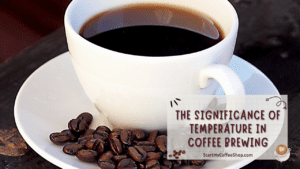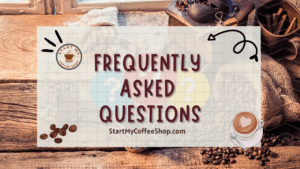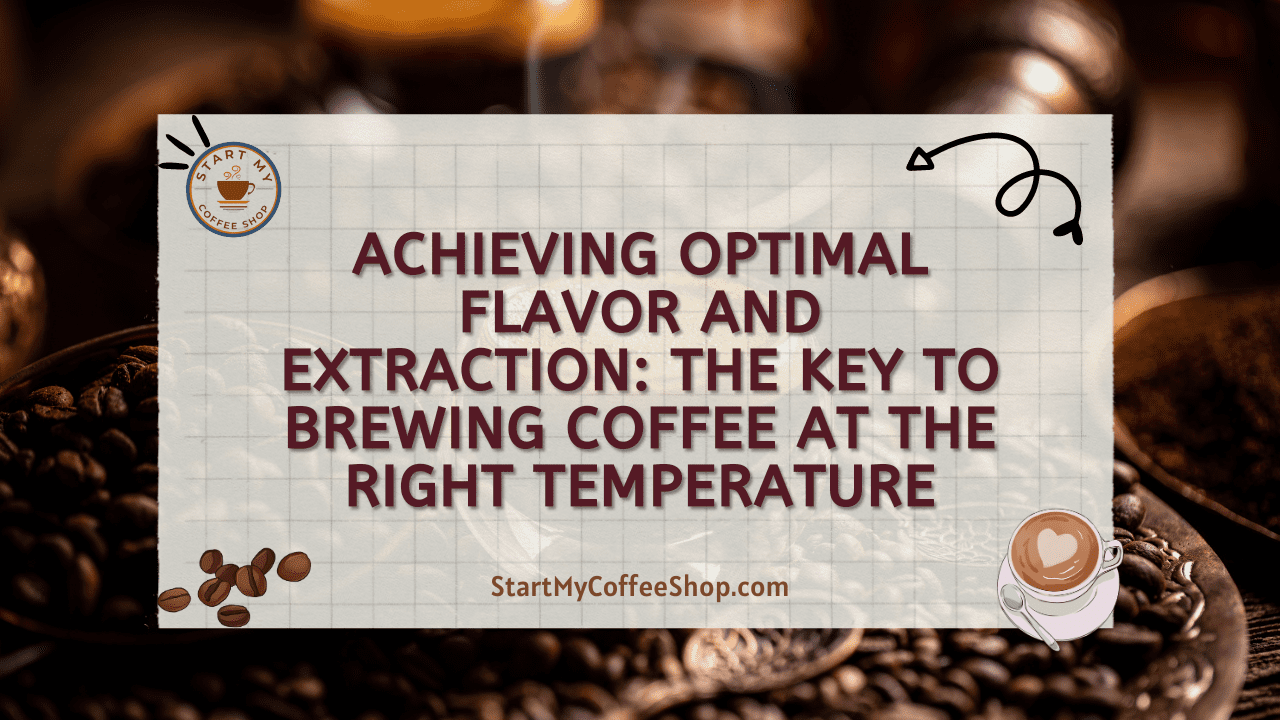When it comes to making coffee, temperature plays a significant role in ensuring that the desired aromas and flavors are extracted. The optimal temperature range encourages correct extraction without contributing an excessive amount of additional bitterness.
To ensure the best flavor and extraction when brewing coffee, you should start with a temperature range between 195°F (90.5°C) and 205°F (96.1°C), which allows for proper extraction without excessive bitterness.
In this article, we will look at the significance of temperature in coffee brewing. Understanding how temperature affects coffee brewing can help coffee lovers discover a world of rich and gratifying tastes in their cup of joe.
The Significance of Temperature in Coffee Brewing

Temperature is one of the most important variables to pay close attention to when brewing coffee because it may make or break the operation. The extraction of chemicals from the coffee grounds is significantly impacted by the temperature at which the coffee is brewed, which in turn affects the overall flavor profile of the brewed coffee.
Coffee grounds start to release soluble solids, oils, acids, and aromatic components when water comes into contact with them. These substances are in charge of giving coffee its varied flavors and fragrances. However, temperature changes have a significant impact on the extraction process.
Under-extraction from brewing coffee at a low enough temperature is possible. A weak and tasteless cup of coffee is produced when the water is not hot enough to sufficiently release the chemicals from the coffee grounds. Under-extraction frequently results in a beverage lacking complexity and failing to maximize the flavor of the coffee beans.
On the other side, over-extraction can result from brewing coffee at a temperature that is too high. Unwanted chemicals like tannins are aggressively extracted from the coffee grounds when the water is excessively hot. As a result, the ideal flavors and smells may be overpowered by a bitter and abrasive taste. The quality of the coffee can be reduced by over-extraction, which can leave a lingering bitterness that hides the intricacies and subtleties of the coffee.
It is essential to brew within the ideal temperature range to obtain the ideal balance and release the maximum flavor potential of your coffee beans. Coffee experts have conducted extensive testing and study, and they have discovered that the ideal temperature range is between 195°F (90.5°C) and 205°F (96.1°C). This temperature range allows the water to adequately extract the beneficial chemicals from the coffee grinds without removing too much bitterness.
The extraction of rich oils, acids, and aromatic components that contribute to a well-rounded and balanced cup of coffee is made possible by brewing within the ideal temperature range. These chemicals interact to produce a nuanced and palatable flavor profile that highlights the distinctive qualities of the coffee beans.
It’s vital to keep in mind that various brewing techniques could call for minor modifications to the temperature range. For instance, precise temperature control is advantageous when using pour-over brewing devices like the Hario V60 or Chemex. The ideal temperature range can be maintained throughout the brewing process with the help of preheating the brewing vessel and utilizing a gooseneck kettle with an integrated thermometer.
On the other hand, French press brewing necessitates a rougher grind and a longer steeping period. It is advised to use water at the higher end of the ideal temperature range, around 205°F (96.1°C), to offset heat loss during the brewing process.
Espresso is made by applying pressure to a bed of finely ground coffee. To avoid over-extraction, the water temperature for espresso should be a little lower, around 195°F (90.5°C). Espresso machines with PID temperature control systems can keep the brewing temperature constant.
It’s important to note that the surroundings or room temperature can also have an impact on the brewing process. The water may cool down more quickly in a colder room, lowering the brewing temperature. On the other hand, a hotter room can make the water retain heat longer, possibly raising the brewing temperature. To keep the brewing temperature at the proper level, it is crucial to pay attention to the ambient temperature and make modifications as necessary.
Read more about: Risk Management Plan for Opening a Coffee Shop: A Caffeinated Shield
The Optimal Temperature Range
The ideal temperature range for brewing coffee has been uncovered via extensive research and trial by coffee professionals. This temperature range, which goes from 195°F (90.5°C) to 205°F (96.1°C), has repeatedly been shown to produce the best taste and extraction.
The water has the requisite heat to extract the desired components from the coffee grounds within the range of temperatures given. These substances include soluble solids, oils, acids, and aromatic compounds, each of which is essential in determining how the brewed coffee will taste overall.
The water helps extract beneficial oils by brewing within the ideal temperature range, which results in a cup with a creamy and smooth mouthfeel. These oils enhance the sensory delight of the coffee by adding depth and richness to the overall flavor experience.
The ideal range enables the extraction of acids found in coffee grounds. The brightness and vibrancy of the coffee’s flavor profile are enhanced by acids. Brewing within this range aids in bringing out the acidic elements that give the flavor profile richness and a nice, tangy sensation.
Within this temperature range, coffee’s aromatic compounds—which give freshly brewed cups their alluring aroma—are also efficiently extracted. These aromatic substances add to the sensory experience as a whole and produce an enticing aroma that makes the coffee more enjoyable.
The precise balance that is achieved by brewing in this temperature range is one of the main benefits. The water isn’t quite hot enough to pull out too much bitterness from the coffee grinds, but it’s still hot enough to efficiently extract the desired chemicals. This keeps the bitterness from becoming overbearing, resulting in a balanced and gratifying cup of coffee.
Bitterness is a potentially unfavorable quality that can obscure the complex flavors and fragrances of coffee. Over-extraction, which is frequently brought on by brewing at too high a temperature, can result in a bitter and harsh flavor. Coffee lovers can reduce the chance of over-extraction, enabling the coffee’s natural flavor to come through, by sticking to the advised temperature range.
Although the recommended temperature range is ideal for brewing coffee in general, individual preferences may differ. Depending on personal preference and the unique qualities of the coffee beans being used, some coffee connoisseurs may prefer a slightly lower or higher brewing temperature. People can customize the brewing process to their liking by experimenting and making acceptable alterations.
Several techniques can be used to guarantee that the brewing temperature is within the acceptable range. The most accurate method for determining the water’s temperature is to use a thermometer. Brewing-specific thermometers, including digital or probe models, can deliver exact readings, enabling fine-grained control over the brewing process.
There are other ways to determine the temperature of the water if you don’t have access to a thermometer. One typical method is to boil the water for a few seconds to a minute, then let it cool down. The water can cool down a little during this brief waiting period, putting it closer to the ideal temperature range.
The equipment that is used for brewing also affects how the temperature is controlled. A pour-over cone or a French press carafe can be preheated to help maintain the proper temperature for more reliable extraction. Purchasing a gooseneck kettle with an integrated thermometer can improve temperature control even further, particularly for pour-over brewing procedures that need exact pouring techniques.
Effects of Brewing Temperature on Flavor
Coffee’s flavor characteristics can be considerably influenced by the temperature at which it is brewed. Let’s investigate how temperature affects several facets of coffee flavor:
- Acidity: Coffee tends to have a brighter and more lively flavor profile when it is brewed at a higher temperature, which tends to boost acidity. On the other hand, brewing at a lower temperature can reduce acidity, resulting in a cup that is smoother and more evenly flavored.
- Bitterness: Over-extraction, which can happen when coffee is brewed at a high temperature, is frequently the cause of excessive bitterness in coffee. You may reduce excessive bitterness by brewing within the ideal range, letting other tastes come through.
- Body and Mouthfeel: The coffee’s viscosity and mouthfeel are influenced by the brewing temperature. A fuller body may emerge at a higher temperature, whilst a lighter, more delicate mouthfeel may arise from a lower temperature.
- Aroma: The release of aromatic molecules during brewing is also influenced by temperature. The aroma of the coffee is enhanced when brewing within the advised range, tantalizing the senses with its smell.
Brewing Methods and Temperature Control
To obtain the best results, different brewing techniques call for particular temperature considerations. Let’s examine some well-known brewing procedures and the temperature management strategies used with them:
- Pour-over Brewing: Pour-over brewing, which makes use of devices like the Chemex or Hario V60, benefits from maintaining perfect temperature control. Maintaining the proper temperature range can be made easier by preheating the brewing vessel, utilizing a gooseneck kettle with an integrated thermometer, and letting the water gently cool after boiling.
- French Press: This technique calls for a rougher grind and a longer steeping period. It is advised to use water at the higher end of the ideal temperature range, around 205°F (96.1°C), to offset the heat lost throughout the brewing process.
- Espresso: The brewing of espresso depends on pressure and a bed of finely ground coffee. To avoid over-extraction, the water temperature for espresso should be close to 195°F (90.5°C). Maintaining constant brewing temperatures is possible with espresso machines equipped with PID temperature control systems.
- Cold Brew: Cold brew is a special brewing technique that involves letting coffee grinds sit for a while in cold or room-temperature water. In contrast to hot brewing techniques, cold brewing progressively removes flavors. The resulting beverage is often smoother and less acidic. Temperature management is less important for cold brew because steeping takes 12 to 24 hours.
Frequently Asked Questions

What happens if I brew coffee at a temperature higher than the recommended range?
Coffee can become bitter and unpleasant-tasting if it is brewed at a temperature higher than that which is advised. The unwanted substances that are released by the coffee as a result of the excessive heating overshadow the intended flavors and smells. To make a cup of coffee that is well-balanced and pleasurable, it is recommended to keep within the ideal temperature range.
Can I still brew coffee if I don’t have a thermometer to measure the water temperature?
It is possible to make coffee without a thermometer, though it is preferred to use one to gauge the water’s temperature for exact brewing. One typical method is to boil the water, let it settle for 30 to 60 seconds, and then pour it over the coffee grinds. During this brief waiting period, the water can slightly cool and get closer to the ideal temperature range. When compared to using boiling water directly, it can help you get better results even if it may not be as accurate as using a thermometer.
Does the temperature of the room or environment affect the brewing process?
Yes, the ambient or room temperature can have some impact on the brewing process. The water may cool down more quickly in a colder room, lowering the brewing temperature. The water may keep heat longer when the room temperature is higher, which could result in a higher brewing temperature. It’s crucial to pay attention to the surrounding temperature and modify it as necessary to keep the brewing temperature at the correct level. Equipment that has been preheated, such as the coffee maker or brewing vessel, can help make up for any temperature loss that may have occurred throughout the brewing process.
To learn more on how to start your own coffee shop, check out my startup documents here.
Disclaimer: The information provided by StartMyCoffeeShop.com (“The Site”) is for general informational purposes only. All information on the Site is provided in good faith. However, we make no representation or warranty of any kind, express or implied, regarding the accuracy, adequacy, validity, reliability, availability, or completeness of any information on the Site. Under no circumstance shall we have any liability to you for any loss or damage of any kind incurred as a result of the use of the Site or Reliance on any information provided on the Site. Your use of the Site and reliance on any information on the Site is solely at your own risk. This blog post is for educational purposes only and does not constitute legal advice. Please consult a legal expert to address your specific needs. Terms and Conditions. (https://startmycoffeeshop.com/terms-and-conditions/)

Hi! I’m Shawn Chun
My adventure in coffee began when I first launched my first coffee shop back in the early 2000s. I had to figure out so many things on my own and to make it worse within 2 years of opening two large corporate coffee chains moved in just blocks away from me!
As I saw smaller and even some larger coffee shops in the neighborhood slowly lose customers to these giant coffee chains and slowly close up shop, I knew that I had to start getting creative…or go out of business.
I (like you may be) knew the coffee industry well. I could make the best latte art around and the foam on my caps was the fluffiest you have ever seen. I even had the best state-of-the-art 2 group digital Nuova Simonelli machine money could buy. But I knew that these things alone would not be enough to lure customers away from the name brand established coffee shops.
Eventually, through lots of trial and error as well as perseverance and creativity I did find a way to not only survive but also thrive in the coffee/espresso industry even while those corporate coffee chains stayed put. During those years I learned to adapt and always faced new challenges. It was not always easy, however, in the end, I was the sole survivor independent coffee shop within a 10-mile radius of my location. Just two corporate coffee chains and I were left after that year. All told the corporate coffee chains took down over 15 small independent coffee shops and kiosks and I was the last one standing and thriving.
Along the years I meet others with the same passion for coffee and I quickly learned that it is not only “how good a barista is” that makes a coffee shop successful, but the business side of coffee as well.
Hence why I started this website you are on now. To provide the tools and resources for up and coming coffee shop owners to gain that vital insight and knowledge on how to start a coffee shop successfully.
Stick around, browse through my helpful blog and resources and enjoy your stay! With lots of LATTE LOVE!
Shawn







